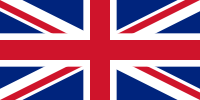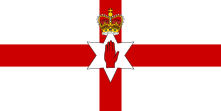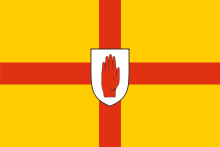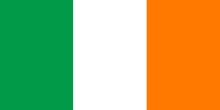- Flag of Northern Ireland
-
 The Union Flag is flown from government buildings in Northern Ireland; Ireland is represented in the flag through the St. Patrick's Cross
The Union Flag is flown from government buildings in Northern Ireland; Ireland is represented in the flag through the St. Patrick's Cross
Northern Ireland has not had its own unique, government-sanctioned flag since the Northern Ireland parliament and government were prorogued in 1972, and abolished in 1973.[1] During official events, the British government uses the Union Flag, which is the official flag of the United Kingdom of Great Britain and Northern Ireland, and is the only flag used by the government in Northern Ireland.[2]
The Ulster Banner remains in use by unionists, a number of sporting organisations in Northern Ireland and some local government authorities under Unionist control.[3]
Contents
Flag of the Government of Northern Ireland (1953-1972)
Main article: Ulster BannerThe "Ulster Banner"[4] is one name that was given to the flag, which can be referred to as "the flag of Northern Ireland", the "[former] Northern Ireland flag", the "Red Hand Flag" or as the "Ulster Flag" (not to be confused with the provincial Flag of Ulster). The Ulster Banner was the official flag that was used to represent the Government of Northern Ireland from 1953 to 1973. In common with other British flags, any civic status of the flag was not defined in law.[5]
In 1924, the Government of Northern Ireland was granted arms (the Coat of arms of Northern Ireland) by Royal Warrant and had the right to display these arms on a flag or banner. This right was exercised for the Coronation in 1953. Between 1953 and 1972, this flag was the arms of the Government of Northern Ireland. When the Parliament of Northern Ireland was dissolved by the British government under the Northern Ireland Constitution Act 1973, the flag ceased to have official standing but remains the only flag to date[update] which represents Northern Ireland at international level in sport.[5]
The flag is based on the flag of England[6][7][8] and the flag of the province of Ulster.[9] As with the flag of the province of Ulster, it contains the Red Hand of Ulster at the centre. The points of the star represent the six counties that make up Northern Ireland.
Official use of flags
There are various practices for the flying of flags by public bodies in Northern Ireland. The Flags Regulations (Northern Ireland) Order 2000 requires that the Union Flag to be flown over specified government buildings including Parliament Buildings and state offices on specified 'named days' (honouring, for example Queen Elizabeth II's official birthday).
The regulations also provides that, on the occasion of a visit to a government building by the British Monarch the Royal Standard shall be flown and the Union Flag can be flown, and on state visits from other heads of state the Union Flag and the national flag of the country of the visitor can be flown. Where two flagpoles exist, the flag of Europe should be flown on Europe Day alongside the Union flag. The regulations prohibit any flags being flown from the relevant buildings except as expressly permitted by the regulations. [10]
Other regulations exist for other public bodies in Northern Ireland. Use of flags by the Police Service of Northern Ireland is governed by the Police Emblems and Flags Regulations (Northern Ireland) 2002, which provides that no flag shall be used by the Service other than its own flag.
Local authorities
Legislation relating to flag flying does not apply to District Council buildings, and District Councils follow a range of practices varying from flying the Union Flag on a number of council buildings every day of the year as at Lisburn, to flying no flags on any building, flying only the council flag or flying flags on the designated days in the same way as government buildings.[11]
In 2004, Belfast City Council commissioned a study on the flying of flags which noted that the Ulster banner is flown, alongside the Union flag by a number of local authorities in Northern Ireland. These include Ards Borough Council, Carrickfergus Borough Council and Castlereagh Borough Council.[12]
Displaying flags
Main article: Northern Ireland flags issueIn Northern Ireland, some members from each 'community' use flags to declare their political allegiances and to 'mark territory'. Unionists and loyalists fly the Union Flag and Ulster Banner to show their support for the union and/or their allegiance to Northern Ireland. Irish nationalists and republicans fly the Irish tricolour to show their support for a United Ireland. They sometimes argue that the Irish tricolour is a symbol of peace and unity between Irish Catholics (Green) and Protestants (Orange), with white symbolising peace.
In sport, the Ulster Banner is carried by the Northern Ireland team in the Commonwealth Games opening ceremony. It is also regularly displayed by supporters of the Northern Ireland national football team.
Peace process
After the 1998 Belfast Agreement, flags continue to be a source of disagreement in Northern Ireland. The Agreement states that:
“ All participants acknowledge the sensitivity of the use of symbols and emblems for public purposes, and the need in particular in creating the new institutions to ensure that such symbols and emblems are used in a manner which promotes mutual respect rather than division. ” Nationalists pointed to this to argue that the use of the Union Flag for official purposes should be restricted, or that the Irish tricolour should be flown alongside the British flag on government buildings. Sinn Fein ministers in the power-sharing Northern Ireland Executive instructed that the Union Flag was not to fly from buildings operated by their respective departments.[13] This power was removed from ministers by virtue of the Flag Regulations (Northern Ireland) Order 2000, mentioned above.
All signatories to the Belfast Agreement also declare their acceptance of the "principle of consent" (i.e. that there will be no change to the constitutional position of Northern Ireland unless a majority votes for it), and Unionists argued that this provision amounts to recognising that the Union Flag is the only legitimate official flag in Northern Ireland.[citation needed] The problem was discussed in detail and various proposals made including suggestions for a new flag.[14]
References
- ^ Under the Northern Ireland Constitution Act 1973
- ^ The Union Flag and flags of the United Kingdom
- ^ uefa.com - Football Europe
- ^ Groom, Nick (2006). The Union Jack: the Story of the British Flag. Atlantic Books. pp. 295. ISBN 1843543362.
- ^ a b Encyclopaedia Britannica says: "According to British tradition, a coat of arms or flag is granted to the government of a territory, not to the people residing there. Therefore, when the government of Northern Ireland was disbanded in March 1972, its arms and flag officially disappeared; however, the flag continues to be used by groups (such as sports teams) representing the territory in an unofficial manner in sport."
- ^ Northern Ireland (United Kingdom)
- ^ CAIN: Symbols - Flags Used in Northern Ireland
- ^ flag of Nordirland to Buy. World flags database
- ^ Northern Ireland (United Kingdom)
- ^ The Flags Regulations (Northern Ireland) 2000
- ^ [www.ofmdfmni.gov.uk/flags.pdf Transforming Conflict: Flags and Emblems] by Dominic Bryan and Gordon Gillespie, Institute of Irish Studies, Queen's University, Belfast, March 2005
- ^ http://www.belfastcity.gov.uk/equality/docs/FlyingOfUnionFlagEQIA.pdf
- ^ Tension over flag flying at BBC News
- ^ Flagging concern: the controversy over flags and emblems
External links
- FOTW: Northern Ireland
- CAIN: Flags in Northern Ireland
- The Union Flags and flags of the United Kingdom
Flags of Europe Sovereign
statesAlbania · Andorra · Armenia · Austria · Azerbaijan · Belarus · Belgium · Bosnia and Herzegovina · Bulgaria · Croatia · Cyprus · Czech Republic · Denmark · Estonia · Finland · France · Georgia · Germany · Greece · Hungary · Iceland · Ireland · Italy · Kazakhstan · Latvia · Liechtenstein · Lithuania · Luxembourg · Macedonia · Malta · Moldova · Monaco · Montenegro · Netherlands · Norway · Poland · Portugal · Romania · Russia · San Marino · Serbia · Slovakia · Slovenia · Spain · Sweden · Switzerland · Turkey · Ukraine · United Kingdom (England • Northern Ireland • Scotland • Wales) · Vatican City
States with limited
recognitionAbkhazia · Kosovo · Nagorno-Karabakh · Northern Cyprus · South Ossetia · Transnistria
Dependencies
and other territoriesÅland · Faroe Islands · Gibraltar · Guernsey · Jan Mayen · Jersey · Isle of Man · Svalbard
Other entities European UnionCategories:- Flags of Northern Ireland
Wikimedia Foundation. 2010.



